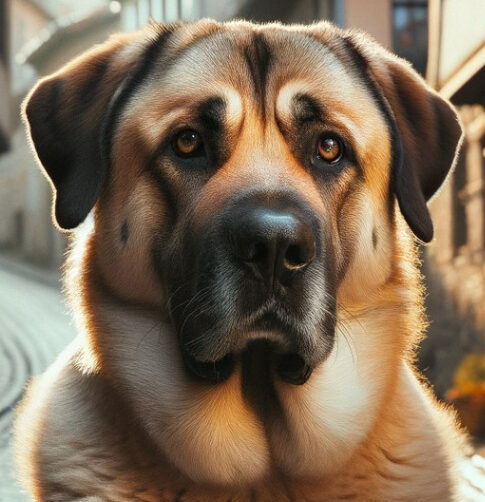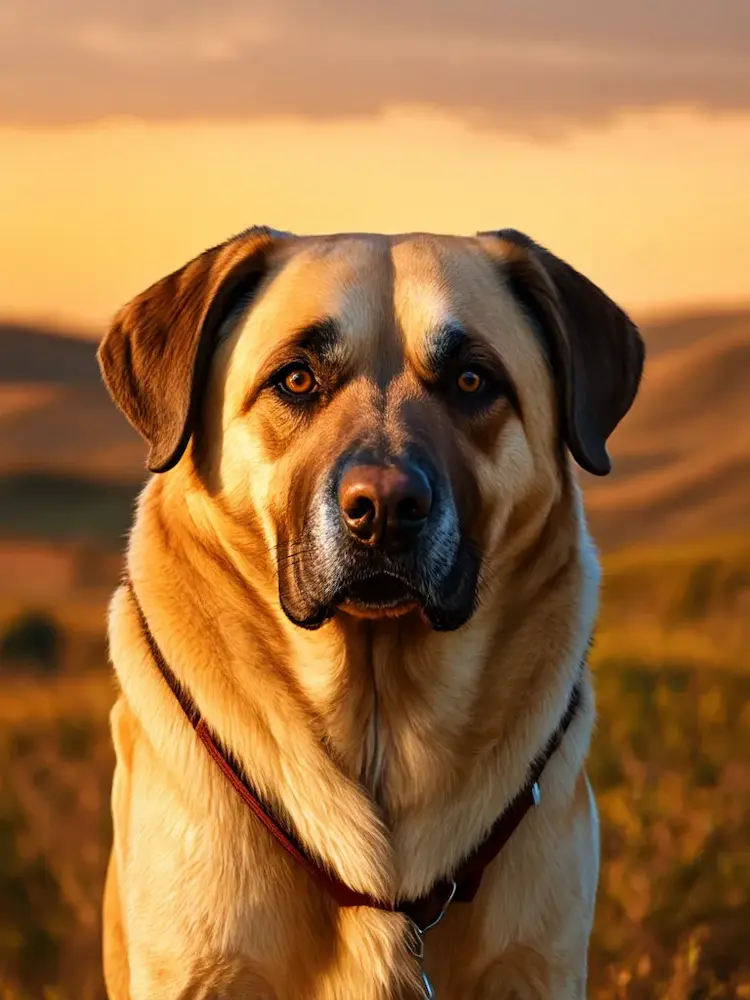🐶 Introduction: Meet the Anatolian Shepherd (Approx. 700 words)
Table of Contents
ToggleThe Anatolian Shepherd is no ordinary dog—this majestic giant carries the legacy of thousands of years of livestock guarding, bred to patrol vast open lands, ward off predators, and protect with unwavering determination. Standing tall with a noble expression, this breed is a powerhouse of instinctual intelligence, territorial devotion, and calm authority.
🧬 What Makes the Anatolian Shepherd Unique?
🦴 Genetically wired for guarding: Unlike most dogs trained for obedience, Anatolian Shepherds are born with the instinct to protect.
🌍 Hails from Turkey: Specifically the Anatolia region, where nomadic shepherds relied on them to safeguard sheep and goats from wolves, bears, and thieves.
🏺 An ancient lineage: This isn’t a trendy breed; it’s an ancient relic of functional canine evolution.
🐺 Not a Lapdog—A Guardian
While some may mistake the Anatolian’s calm demeanor for laziness, make no mistake—this breed is watching, waiting, and analyzing. It may not jump excitedly at every command, but it knows exactly what’s going on.
🚨 Important Note: Anatolian Shepherds are not ideal for first-time dog owners. They require firm leadership, socialization, and structured environments. Without guidance, their natural independence can become overwhelming.
🐾 Wild Fact #1: Ancient Origins and Nomadic Roots (Approx. 800 words)
The Anatolian Shepherd is as old as civilization itself. Archaeological evidence suggests that dogs resembling Anatolians date back over 4,000 years in the region now known as Turkey. These dogs were never “pets”—they were lifesaving tools, bred to protect flocks from predators across harsh and unforgiving terrain.
🛕 From Ancient Temples to Open Fields
🏺 Historical records: Mesopotamian carvings and early Turkish texts mention dogs similar to Anatolians.
🐪 Used by nomads: Turkish nomadic tribes depended on these dogs to move across vast steppes and mountains.
⚖️ Selective breeding: Only the strongest, most loyal, and most aware dogs were allowed to reproduce—resulting in today’s confident and stoic breed.
🔗 Close Cousins: Kangal & Akbash
The Anatolian Shepherd is often confused with its Turkish cousins:
-
Kangal: More powerful and with a stronger bite force, but often lumped in as the same breed.
-
Akbash: White-coated guardian dog with similar instincts.
🧠 Fun Fact: In the U.S., the Anatolian Shepherd has been recognized as a separate breed since 1996 by the AKC, though many global registries group Kangals and Anatolians together.
📿 Cultural Significance in Turkey
In rural Anatolia, owning a good guardian dog is a matter of family pride and survival. These dogs aren’t just animals—they’re protectors of livelihood. Villagers will still tell stories of Anatolians chasing off wolves and even bears to defend livestock.
🐘 Wild Fact #2: Gigantic Size, Gentle Strength (Approx. 1,000 words)
Anatolian Shepherds are among the largest dog breeds in the world, yet they carry their massive frame with surprising grace and calmness. They are not clumsy oafs—these dogs are as strategic as they are strong.
📏 Size & Weight Specifications
| Trait | Male Anatolian Shepherd | Female Anatolian Shepherd |
|---|---|---|
| Height | 29–32 inches (at shoulder) | 27–31 inches (at shoulder) |
| Weight | 110–150 lbs 🏋️ | 80–120 lbs 🐕 |
| Build | Muscular, lean, athletic 🏃♂️ | Solid, balanced, agile 🐾 |
🔍 Interesting Insight: Despite their bulk, Anatolian Shepherds can run up to 35 mph for short bursts to chase off predators. That’s faster than a German Shepherd or a Golden Retriever!
💪 Built for Purpose, Not Fluff
While many large breeds were bred for companionship or hunting, Anatolians were bred to work independently, often far from human supervision. That means:
-
🧭 Sharp awareness of surroundings
-
🚧 High endurance to patrol land for hours
-
💣 Powerful jaws capable of fighting off predators
-
🧊 Thick, double-layered coat to protect from heat and cold
🧸 Not a Cuddly Giant—But a Respectful One
While Saint Bernards or Newfoundlands may seek out snuggles, Anatolians often prefer quiet companionship. They’re not aloof—they’re reserved.
💬 Owners often describe them as:
-
🧘 “Calm and serious around the house”
-
🐾 “Uninterested in strangers but deeply bonded with their family”
-
👀 “Always watching… even when you think they’re sleeping”
🤝 How They Treat Other Animals
✅ Well-socialized Anatolians can live peacefully with cats, small dogs, and even chickens—if they grow up together.
⚠️ But introducing new animals later in life can be challenging without slow, structured socialization.
🐑 Their natural instinct is to protect, not play. They often treat smaller animals as “flock members,” not toys.
⚖️ Comparison With Other Giant Breeds
| Breed | Size Range | Temperament | Energy Level | Guarding Instincts |
|---|---|---|---|---|
| Anatolian Shepherd | 80–150 lbs 🦴 | Reserved, loyal, watchful | Moderate ⚡ | Very high 🔥 |
| Great Dane | 100–200 lbs 🐾 | Friendly, gentle, goofy | Low 💤 | Low 🧸 |
| Saint Bernard | 120–180 lbs 🍂 | Sweet, calm, lazy | Low 💤 | Moderate 🛡️ |
| Kangal | 90–145 lbs 🐃 | Protective, strong-willed | Moderate ⚡ | Very high 🔥 |
| Mastiff | 130–230 lbs 💪 | Docile, stubborn, powerful | Low to medium | High 🛡️ |
⚖️ Pros & Cons of Giant Size
✅ Pros:
-
🚨 Excellent deterrent just by appearance
-
🛡️ Natural guardian instincts
-
🐾 Moves gracefully despite size
-
🧠 Surprisingly gentle with kids and smaller pets when socialized
❌ Cons:
-
🍽️ High food bills!
-
🏥 More expensive vet visits, medication, and surgery
-
🚗 Needs XL car space and XXL crates
-
🧹 Massive shedding and drool (especially during seasonal coat changes)
🛑 Not Meant for Apartments
Even though Anatolians aren’t hyperactive indoors, they’re not suited to cramped spaces. They thrive in:
-
🏡 Rural homes
-
🚜 Farms
-
🧱 Large backyards with fencing
-
🐑 Livestock ranches
🧱 Minimum fence height should be 6 feet, as Anatolians can jump, dig, or test weak spots if they feel their territory needs defending.
🧠 Wild Fact #3: Fierce Loyalty, Natural Guarding Instincts (Approx. 1,000 words)
Anatolian Shepherds were bred with one job in mind: guard the flock at all costs. This ancient instinct is so strong that even modern Anatolians, raised in suburban homes, will:
-
Bark loudly at strangers 🚨
-
Patrol your yard at night like a security guard 🕵️
-
Stand between your children and unknown visitors 🧍♂️🧒
💼 Livestock Guardian Dogs (LGDs): What It Means
The Anatolian Shepherd is a true LGD, not a herder. Unlike Border Collies or Australian Shepherds, which push livestock, Anatolians protect them.
Key characteristics of LGDs:
-
🕶️ Stay calm under pressure
-
👁️ Evaluate threats independently
-
🐺 React with aggression only when necessary
-
🧍 Can stay alone for long periods with livestock
👨👩👧 Fiercely Loyal to Their People
They’re not the type to run around the dog park wagging their tails at strangers. Anatolian Shepherds bond deeply—but selectively. They:
-
Form tight-knit connections with their families 👨👩👧
-
Tend to choose one primary human as their leader 🧑🤝🧑
-
Remain aloof or even suspicious of visitors unless introduced slowly 👀
🔔 Alarm System with Teeth
Their guarding instinct means:
-
Barking begins the second someone nears your property 🚨
-
Growling if someone threatens a family member 🛡️
-
Attacking only when provoked or if the threat escalates
⚠️ Caution: Improperly socialized Anatolians may become overprotective. These dogs must be trained not to see every visitor as a threat.
🧩 Wild Fact #4: Highly Independent Thinkers (Approx. 1,000 words)
One of the most defining traits of Anatolian Shepherds—and one of the biggest surprises for new owners—is their independence.
This breed was developed to work alone, often miles from human contact, deciding how to deal with predators on its own. That means obedience isn’t second nature—critical thinking is.
🧠 Thinking for Themselves
While many breeds obey commands eagerly (like a Labrador or Golden Retriever), the Anatolian often questions you:
-
🗣️ “Why should I do that?”
-
🧭 “Is that command really necessary right now?”
-
👀 “Do I see a more efficient way to handle this?”
While this doesn’t mean they’re stubborn, it means they are:
-
🧠 Independent problem solvers
-
🤔 Decision-makers
-
🧘 Introspective and self-reliant
🧑🏫 Training Anatolians: A Different Ballgame
✅ You can train them—but not like a Border Collie.
Here’s what works:
-
🍖 High-value treats (turkey, cheese, liver)
-
🔁 Short, consistent sessions (5–10 minutes max)
-
📢 Calm, firm commands
-
🤝 Building mutual respect—not blind obedience
❌ What doesn’t work:
-
📣 Yelling
-
💥 Harsh corrections
-
🦴 Repetitive drills
-
🚫 Over-praising (they don’t care for “Good boy!” 100 times)
🔄 Real-World Examples of Their Thinking
Imagine this: Your Anatolian is outside, and a neighbor walks by the fence. You call your dog, but he just stares and watches the neighbor carefully.
Why?
Because in his mind, his job is to assess the threat first, then respond to your call.
This is not disobedience—this is guardian protocol.
🧘 The Pros and Cons of Their Independence
✅ Pros:
-
🚪 Can be left alone outside without constant supervision
-
🛡️ Acts autonomously to defend property
-
🧠 Great for working farms or rural homes
-
🧬 Doesn’t rely on constant validation
❌ Cons:
-
🧍 Harder to off-leash train in open areas
-
🧹 Not ideal for apartment obedience classes
-
🗣️ Can ignore basic commands if they feel it’s not urgent
-
🔁 Requires patience and experience to train properly
🏡 Wild Fact #5: Not Your Average Family Dog (Approx. 1,000 words)
If you’re looking for a dog to cuddle with toddlers, play fetch for hours, or attend doggy playdates every weekend—this breed may not be your match.
Anatolian Shepherds can be great family dogs, but they’re very different from the traditional image of one.
👶 Children and Anatolians
Anatolians often bond very deeply with the children in their household, seeing them as part of the flock. This can be heartwarming and protective—but it also means:
-
🔔 They may become possessive or wary when other children approach “their” kids
-
🧸 They do better with older, respectful children
-
🚫 Roughhousing can be misinterpreted as aggression
🧠 Pro tip: Always supervise Anatolians with children, especially guests.
🐕 Other Dogs & Pets
When raised with other animals from a young age, Anatolians can live peacefully with:
-
🐈 Cats
-
🐓 Chickens
-
🐐 Goats
-
🐕 Other dogs (if well matched in energy & temperament)
However:
-
🐶 They often don’t enjoy dog parks
-
🐾 May become territorial toward strange dogs
-
🦴 Same-sex aggression is more likely if unneutered
🚷 Visitors & Social Settings
This breed is not naturally social with outsiders. Don’t expect your Anatolian to greet guests with tail wags and kisses.
Instead, they will:
-
👀 Watch quietly from a distance
-
🔊 Bark if someone enters without invitation
-
🚪 Only accept visitors after a proper introduction
👨👩👧 Ideal Homes for Anatolian Shepherds
🏡 Perfect for:
-
Rural or suburban homes with large, fenced yards
-
Homesteads with livestock
-
Families with experience in large or independent breeds
-
Owners who don’t mind a more serious, working-style dog
🏙️ Not ideal for:
-
Apartment living
-
Frequent dog park or socialization environments
-
Homes with toddlers and chaotic energy
-
People who want cuddly, ultra-obedient dogs
📊 Anatolian Personality Snapshot
| Trait | Rating (1–5) |
|---|---|
| Loyalty 🫶 | ⭐⭐⭐⭐⭐ |
| Obedience 🎯 | ⭐⭐ |
| Intelligence 🧠 | ⭐⭐⭐⭐ |
| Playfulness 🧸 | ⭐⭐ |
| Protectiveness 🛡️ | ⭐⭐⭐⭐⭐ |
| Stranger Friendliness 😐 | ⭐ |
| Child Friendliness 👶 | ⭐⭐⭐ |
| Dog Compatibility 🐕 | ⭐⭐ to ⭐⭐⭐ |

